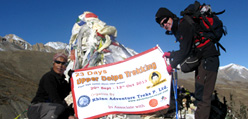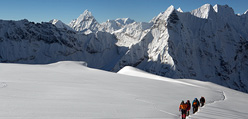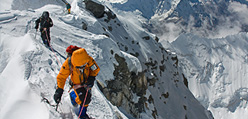Email : info@nepaltrekkingpackage.com
+977 - 01 - 4701300
When to trek
Our itineraries include treks that last from anywhere between two days and one month (even more in some tailored cases), and so you will need to pick a route that fits your timeframe and physical condition. You’ll also want to consider the weather in a particular area, and whether or not you want to trek in crowded areas or go further off the beaten track.
The trekking season in Nepal falls between October and May, although some high altitude routes will be closed between the middle of December until the end of January, because of heavy snowfall.
The nights can be very cold during the Winter, but during the day the sun provides pleasant, comfortable walking temperatures. Of course, this is less so at higher altitude, when you will require warmer clothing during the night and layers that can be easily removed during the day.
Most of the rain in the Himalayan region falls during the monsoon, and so at this time there is less snow even on the higher trails. There are of course, always chances that these patterns will change, and so you should be prepared for extremes and should discuss the weather with our advisors before you embark upon your journey. Snowstorms are common in December and January, making crossing high mountain passes especially challenging. In particular, trekking in the Annapurna Sanctuary area can be difficult during this time, but your guide will always assess the safety of a given route, talking to local people and using their years of experience to inform any decision. It is crucial at these times that you follow the instructions of your guide.
The mid-hills around Pokhara tend to be dusty and hazy in April and May, but this will clear when you enter higher altitudes. The advantage of trekking in the summer and the monsoon is that you will have the routes almost completely to yourself, enabling you to experience the Himalayas without the crowds, but be wary of rain, leeches and slippery trails.
In the springtime, you may experience sudden and destructive thunderstorms and high winds – again your guide will provide you with logistical support during these times and it is vital to heed their warnings.
The best time to come to Nepal
Nepal’s climate varies dramatically depending on the area that you are in. Nepal’s topography ranges from tropical in the Tarai to arctic in the mountains. In the Tarai, the climate can be hot and humid. The mid-hills are pleasant all year round, but Winter nights can be very cold. In the mountain region of the North, you can expect temperatures to drop significantly at night.
The seasons
In order to better explain Nepal’s varied climate, we have provided some more detail about the seasons. You can use this information to help you decide which itinerary is for you.
Spring (March – May)
During Spring you will experience warm temperatures at lower altitudes and moderate temperatures higher up. The chances of clear, unobstructed mountain views are good, and it is also a good time to see Nepal’s flowers blossom.
Summer (June – August)
This is the monsoon season in Nepal, where weather can be hot, humid and rainy. Generally, you will find that the humidity builds up during the day, and in the late afternoon, there will often be a thunderstorm. This does, however, mean that skies are relatively clear in the early mornings – and this will be the best time to trek during the monsoon.
This is a particularly good time to trek in the otherwise dry areas of Upper Mustang, Kailash and Dolpo. If you are particularly interested in botany, this is a good time to see Nepal’s plant life in all its glory.
Autumn (September – November)
This is the preferred trekking season in Nepal. You will be almost guaranteed excellent mountain views, but be wary – this is the peak trekking season in Nepal, so be sure to book your flights in advance and be prepared for more crowded trekking routes. During this time, you’ll also be able to see and participate in the biggest festivals in Nepal – Dasain and Tihar.
Winter (December – February)
During the Winter, you’ll find that the weather is cool, and there is much snowfall at high altitudes. It is a good idea to embark upon lower altitude treks during this season, which will be comparatively comfortable.


